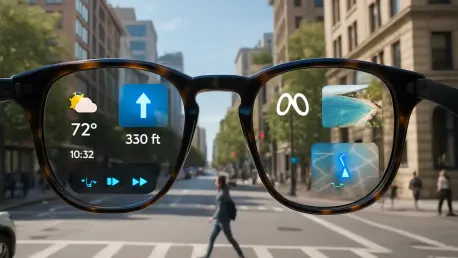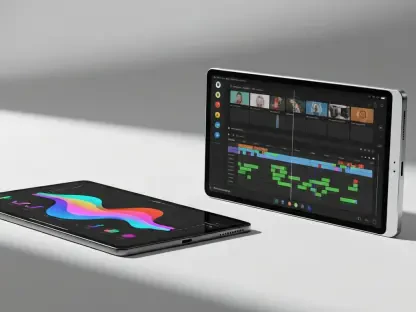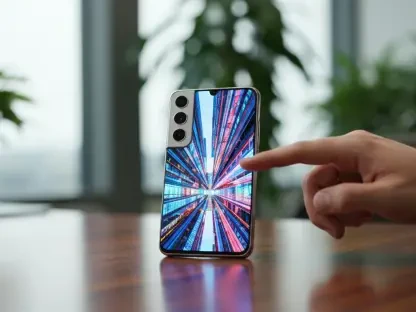Imagine stepping into a world where your eyewear does more than just correct vision—it overlays navigation directions, captures moments hands-free, and responds to voice commands seamlessly, transforming the way you interact with both digital and physical environments. This is the promise of Meta Smart Glasses, a groundbreaking fusion of augmented reality (AR) and stylish design that has redefined wearable technology in 2025. Developed through strategic partnerships with iconic brands like Ray-Ban and Oakley, these glasses aim to integrate cutting-edge tech into daily life without sacrificing aesthetics. This review delves into the intricacies of Meta Smart Glasses, evaluating their features, performance, and transformative potential in both personal and professional spheres.
Background and Evolution of the Technology
Meta’s journey into wearable tech has been marked by a bold vision to merge digital and physical realities, with smart glasses emerging as a cornerstone of this ambition. Collaborations with Ray-Ban and Oakley have allowed Meta to combine fashion with functionality, creating eyewear that appeals to a broad consumer base while embedding advanced AR and AI capabilities. These partnerships have evolved over recent years, refining the balance between sleek design and technological prowess, positioning Meta as a leader in this niche.
The core principle behind Meta Smart Glasses lies in their integration of AR to provide contextual information directly in the user’s field of view, paired with AI-driven features for intuitive interaction. Unlike traditional VR headsets that fully immerse users, these glasses focus on subtle enhancements, such as peripheral displays for notifications or maps. This approach reflects a deliberate strategy to make AR accessible for everyday use without overwhelming the wearer.
In the broader landscape of consumer electronics, Meta Smart Glasses stand out as a pivotal step toward mainstream AR adoption. They address a growing demand for wearables that blend seamlessly into lifestyles while offering practical utility. As competitors race to develop similar solutions, Meta’s emphasis on style and user-friendly tech underscores its relevance in shaping the future of personal devices.
Key Features and Performance Analysis
Augmented Reality Capabilities
One of the standout aspects of Meta Smart Glasses is their AR functionality, which offers peripheral displays for essential information like notifications, navigation cues, and photo previews. This feature ensures users can stay informed without needing to glance at a separate device, enhancing convenience during tasks like commuting or multitasking. The display, though limited to one eye in some models, provides clear visuals in well-lit conditions, making it a practical tool for quick glances.
Real-world testing reveals that the AR elements perform admirably in dynamic environments, such as busy urban streets, where directions overlay directly onto the surroundings. However, the immersion level falls short of full-scale AR headsets, as the field of view remains narrow. Despite this, the technology significantly boosts productivity by reducing dependency on handheld screens for basic interactions.
The significance of these AR capabilities lies in their potential to redefine daily routines. From displaying incoming messages during a meeting to guiding users through unfamiliar areas, Meta Smart Glasses offer a glimpse into a future where digital assistance is effortlessly integrated into physical spaces. This balance of utility and subtlety marks a key strength of the product.
Design and Comfort
Aesthetically, Meta Smart Glasses excel through their collaboration with Ray-Ban and Oakley, offering frame styles that cater to diverse tastes, from classic to sporty. The design prioritizes a discreet incorporation of tech components, ensuring the glasses resemble conventional eyewear rather than clunky gadgets. This attention to visual appeal makes them suitable for both casual and professional settings.
Comfort is another critical area where these glasses shine, with lightweight materials and ergonomic fits that support extended wear. Users report minimal strain even after hours of use, thanks to balanced weight distribution and adjustable frames. The construction quality, featuring durable yet flexible materials, further enhances their appeal for active lifestyles.
Beyond mere looks, the design also considers practicality, with features like integrated speakers and microphones discreetly placed within the frames. This thoughtful engineering ensures that Meta Smart Glasses are not just a tech novelty but a wearable that complements everyday fashion while delivering functionality, setting a high standard for competitors.
AI Integration and Camera Specifications
The AI capabilities embedded in Meta Smart Glasses elevate their utility through voice-activated commands and contextual assistance. Users can dictate messages, set reminders, or query information hands-free, with the AI responding promptly in most scenarios. This integration proves especially valuable in situations requiring quick access to data without manual input.
Camera specs also impress, with built-in lenses capable of capturing high-resolution photos and videos, even in moderate lighting conditions. The field of view, while not as expansive as standalone cameras, suffices for casual recording and AR-enhanced previews. Low-light performance, however, remains an area for improvement, as images can appear grainy under dim conditions.
Together, the AI and camera features create a cohesive experience that empowers users to document moments and interact with digital tools effortlessly. Whether snapping a quick photo during a hike or receiving real-time translations via voice prompts, these elements underscore the glasses’ role as a versatile companion in modern life.
Recent Innovations and Market Trends
Meta continues to push boundaries with its smart glasses portfolio, introducing advancements like the speculated “Celeste” model, which reportedly offers enhanced AR displays for a more immersive experience. Unveiled at recent tech showcases, such innovations hint at a trajectory toward more sophisticated features while maintaining a consumer-friendly form factor. This focus reflects Meta’s commitment to staying ahead in a rapidly evolving field.
Market trends in wearable tech further contextualize Meta’s strategy, with a noticeable shift toward lightweight AR devices that prioritize style alongside functionality. Consumer demand increasingly favors products that integrate seamlessly into daily attire, a niche where Meta Smart Glasses excel through their branded collaborations. This alignment with user preferences positions the product favorably against emerging competitors.
Additionally, Meta’s strategic emphasis on AR over other wearables, such as smartwatches, highlights a deliberate pivot in resource allocation. Recent events have showcased a clear intent to refine AR experiences before diversifying into other hardware categories. This targeted approach suggests a long-term vision to dominate the AR wearables space before expanding broader tech ambitions.
Real-World Applications and Use Cases
In practical settings, Meta Smart Glasses prove invaluable for tasks like hands-free navigation, where AR overlays provide turn-by-turn directions without the need for a smartphone. This functionality is particularly useful for cyclists or pedestrians in urban environments, allowing uninterrupted focus on surroundings. Similarly, media consumption becomes more intuitive with direct access to notifications or playback controls.
Specific industries also benefit from tailored applications of this technology, such as fitness, where the glasses can display workout metrics in real time, or education, where AR visuals aid in interactive learning experiences. These specialized uses demonstrate the adaptability of Meta Smart Glasses beyond general consumer needs, opening doors to professional utility.
Unique integrations, such as pairing with smart bands for enhanced AR control, further expand their versatility, while consumer feedback often praises their ability to handle diverse scenarios, from travel to remote work. Such adaptability underscores the product’s potential to cater to a wide array of user demands, reinforcing its relevance across contexts.
Challenges and Limitations
Despite their strengths, Meta Smart Glasses face technical hurdles, notably in battery life, which struggles to support prolonged AR usage without frequent recharging. This limitation can disrupt extended sessions, requiring users to plan usage carefully. Compared to full-scale AR headsets, the immersion level also remains constrained, limiting deeper interactive experiences.
Market challenges include premium pricing for advanced models, which may deter budget-conscious buyers in a competitive landscape filled with alternative AR wearables. Brands offering lower-cost solutions pose a threat to widespread adoption, especially as Meta targets both high-end and accessible segments. Balancing cost with innovation remains a critical obstacle.
To address these issues, Meta has initiated software updates to optimize power efficiency and refine AR interfaces, alongside hardware tweaks for future iterations. While these efforts show promise, overcoming price barriers and enhancing battery endurance will be crucial to maintaining a competitive edge in an increasingly crowded market.
Future Outlook for the Technology
Looking ahead, Meta Smart Glasses are poised for significant advancements, particularly in AR display technology, with potential for wider fields of view and more immersive overlays. Speculation around upcoming models suggests a focus on bridging the gap between current peripheral displays and full AR environments. Such progress could redefine user expectations over the next few years.
Broader accessibility through varied price points also appears on the horizon, with Meta likely to introduce tiered options to capture diverse market segments. This strategy could accelerate consumer adoption, making AR eyewear a staple rather than a luxury. The anticipated impact of these developments promises to democratize cutting-edge tech for wider audiences.
Long-term, Meta’s dedication to AR signals a transformative influence on societal interactions, potentially altering how individuals engage with information and each other. As the tech industry evolves, this focus on AR wearables may set new standards for connectivity and convenience, positioning Meta as a pioneer in reshaping digital experiences.
Final Thoughts and Verdict
Reflecting on this evaluation, Meta Smart Glasses impressed with their innovative blend of design, AR functionality, and AI integration, marking a notable achievement in wearable tech. Their ability to merge style with utility through partnerships with Ray-Ban and Oakley stood out as a defining strength. Performance in real-world scenarios consistently highlighted their potential to enhance daily tasks.
However, challenges like limited battery life and premium pricing tempered expectations, revealing areas where refinement is needed. Meta’s ongoing efforts to address these drawbacks through updates and strategic planning showed a commitment to improvement. The competitive standing of the glasses remained strong, despite market obstacles.
Looking forward, the next steps for Meta involve prioritizing battery optimization and exploring cost-effective models to broaden reach, while continuing to push AR boundaries. Stakeholders and consumers alike can anticipate exciting iterations that build on this foundation, potentially revolutionizing wearable tech adoption. The journey of Meta Smart Glasses hints at a future where seamless digital integration becomes the norm, offering a compelling vision to watch unfold.









